Healthcare Management and Operations
VerifiedAdded on 2020/10/22
|11
|3842
|148
AI Summary
This assignment delves into various aspects of healthcare management, including research policies and systems, health care operations management, educational interventions for managing COPD in primary care, challenges of managing people with multimorbidity, creating shared value in healthcare, understanding and managing complexity, safety and ethics in healthcare, project management for healthcare, customer effort in value cocreation activities, measuring teamwork in healthcare settings, big data analytics in healthcare, essential characteristics of resilience, and the WHO global strategy on people-centred and integrated health services. It provides a comprehensive overview of the key concepts and challenges in healthcare management.
Contribute Materials
Your contribution can guide someone’s learning journey. Share your
documents today.
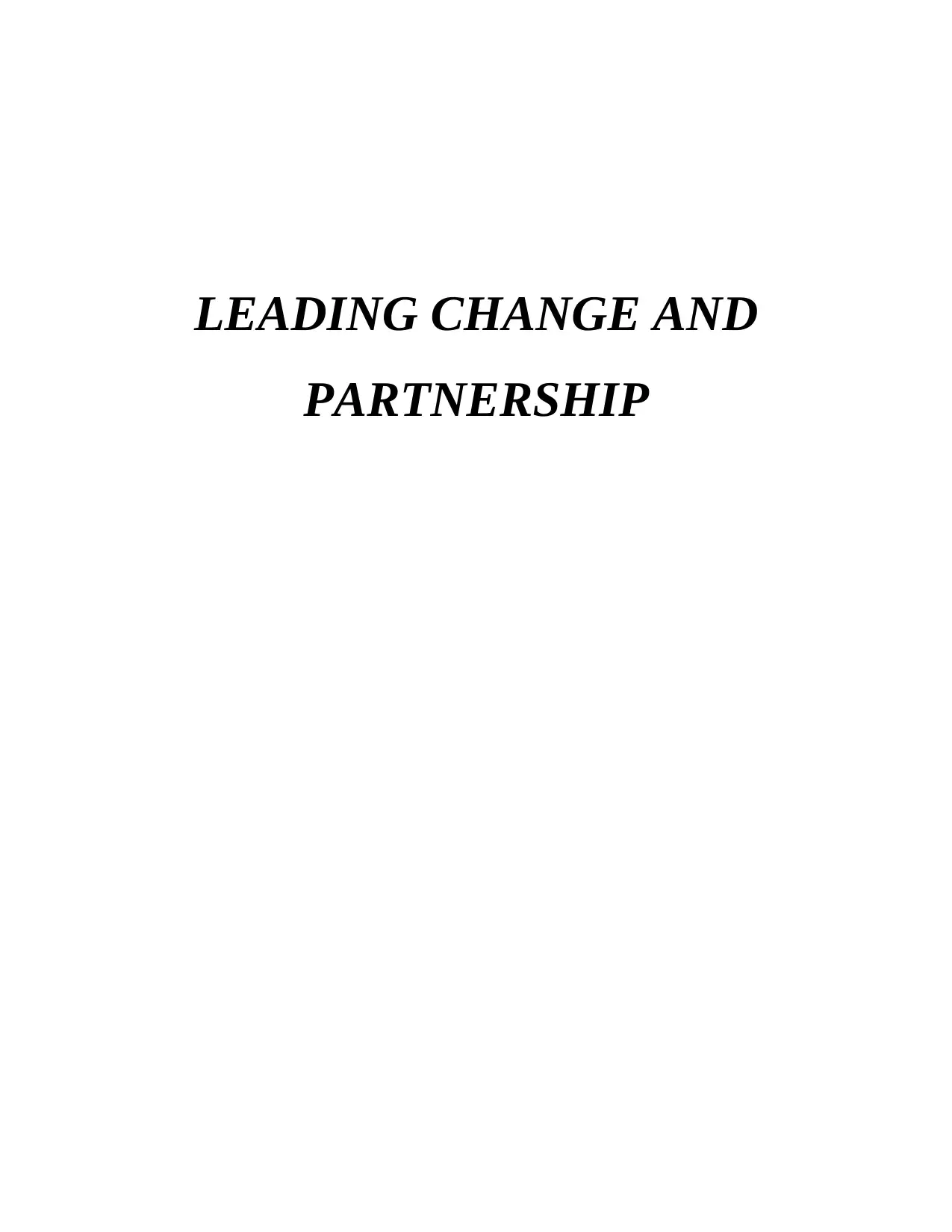
LEADING CHANGE AND
PARTNERSHIP
PARTNERSHIP
Secure Best Marks with AI Grader
Need help grading? Try our AI Grader for instant feedback on your assignments.
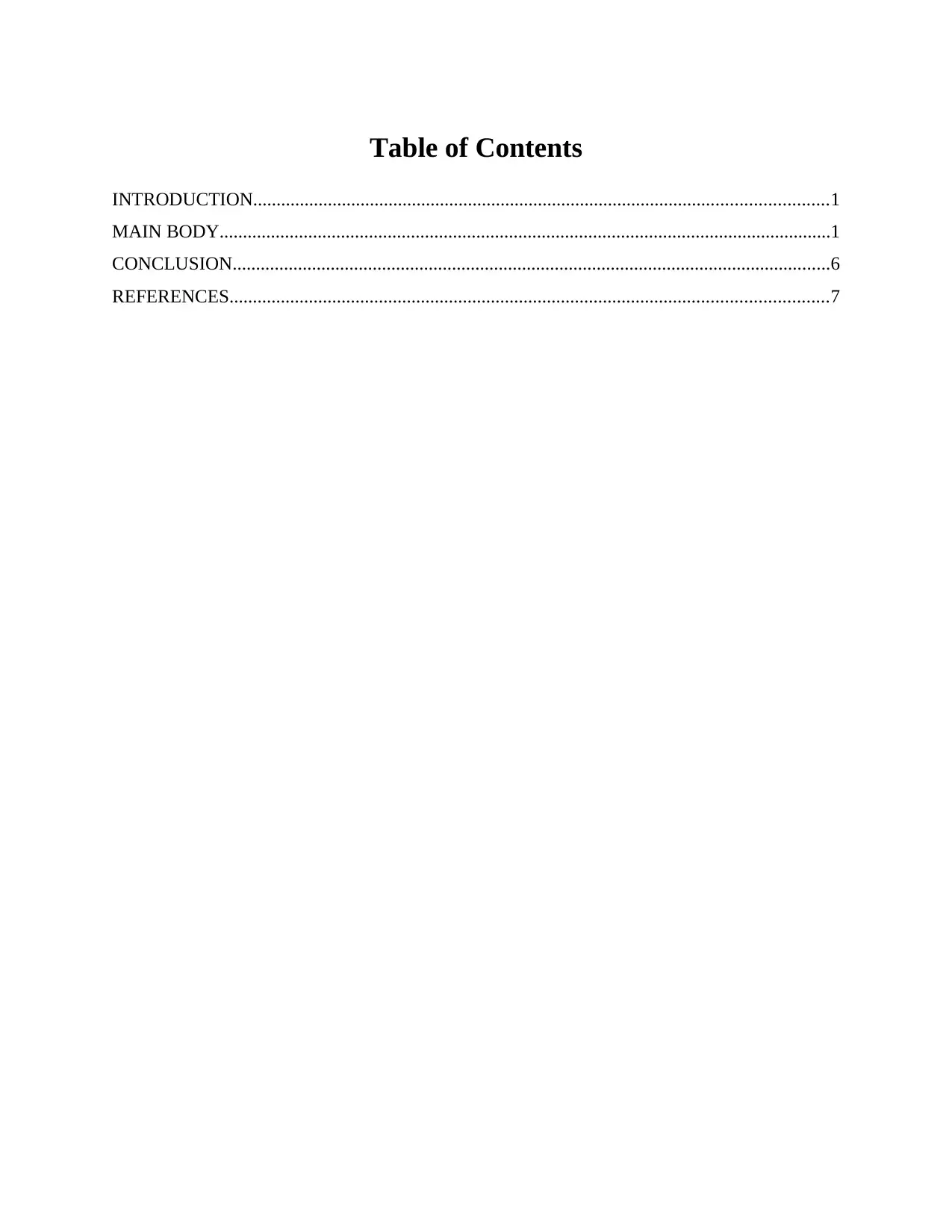
Table of Contents
INTRODUCTION...........................................................................................................................1
MAIN BODY...................................................................................................................................1
CONCLUSION................................................................................................................................6
REFERENCES................................................................................................................................7
INTRODUCTION...........................................................................................................................1
MAIN BODY...................................................................................................................................1
CONCLUSION................................................................................................................................6
REFERENCES................................................................................................................................7
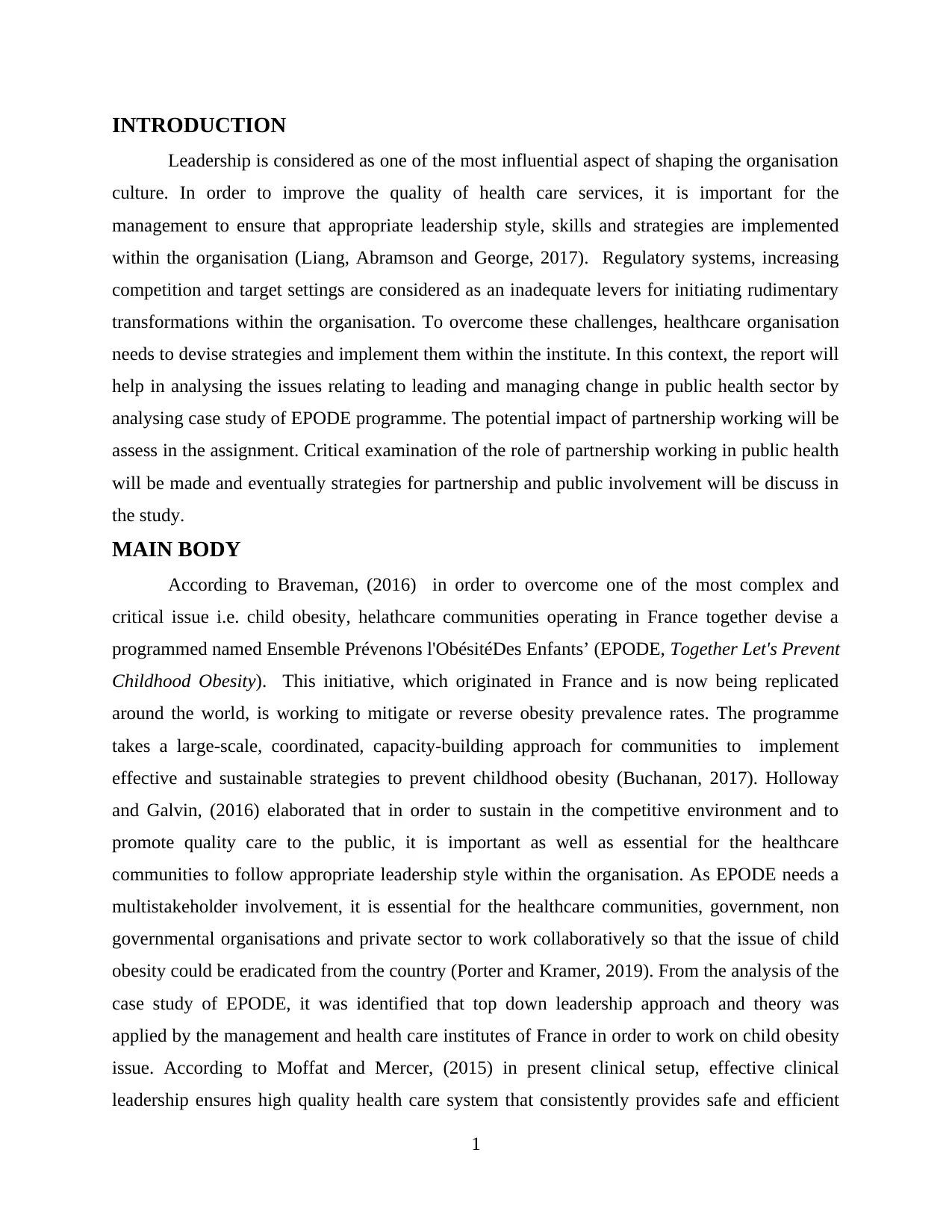
INTRODUCTION
Leadership is considered as one of the most influential aspect of shaping the organisation
culture. In order to improve the quality of health care services, it is important for the
management to ensure that appropriate leadership style, skills and strategies are implemented
within the organisation (Liang, Abramson and George, 2017). Regulatory systems, increasing
competition and target settings are considered as an inadequate levers for initiating rudimentary
transformations within the organisation. To overcome these challenges, healthcare organisation
needs to devise strategies and implement them within the institute. In this context, the report will
help in analysing the issues relating to leading and managing change in public health sector by
analysing case study of EPODE programme. The potential impact of partnership working will be
assess in the assignment. Critical examination of the role of partnership working in public health
will be made and eventually strategies for partnership and public involvement will be discuss in
the study.
MAIN BODY
According to Braveman, (2016) in order to overcome one of the most complex and
critical issue i.e. child obesity, helathcare communities operating in France together devise a
programmed named Ensemble Prévenons l'ObésitéDes Enfants’ (EPODE, Together Let's Prevent
Childhood Obesity). This initiative, which originated in France and is now being replicated
around the world, is working to mitigate or reverse obesity prevalence rates. The programme
takes a large-scale, coordinated, capacity-building approach for communities to implement
effective and sustainable strategies to prevent childhood obesity (Buchanan, 2017). Holloway
and Galvin, (2016) elaborated that in order to sustain in the competitive environment and to
promote quality care to the public, it is important as well as essential for the healthcare
communities to follow appropriate leadership style within the organisation. As EPODE needs a
multistakeholder involvement, it is essential for the healthcare communities, government, non
governmental organisations and private sector to work collaboratively so that the issue of child
obesity could be eradicated from the country (Porter and Kramer, 2019). From the analysis of the
case study of EPODE, it was identified that top down leadership approach and theory was
applied by the management and health care institutes of France in order to work on child obesity
issue. According to Moffat and Mercer, (2015) in present clinical setup, effective clinical
leadership ensures high quality health care system that consistently provides safe and efficient
1
Leadership is considered as one of the most influential aspect of shaping the organisation
culture. In order to improve the quality of health care services, it is important for the
management to ensure that appropriate leadership style, skills and strategies are implemented
within the organisation (Liang, Abramson and George, 2017). Regulatory systems, increasing
competition and target settings are considered as an inadequate levers for initiating rudimentary
transformations within the organisation. To overcome these challenges, healthcare organisation
needs to devise strategies and implement them within the institute. In this context, the report will
help in analysing the issues relating to leading and managing change in public health sector by
analysing case study of EPODE programme. The potential impact of partnership working will be
assess in the assignment. Critical examination of the role of partnership working in public health
will be made and eventually strategies for partnership and public involvement will be discuss in
the study.
MAIN BODY
According to Braveman, (2016) in order to overcome one of the most complex and
critical issue i.e. child obesity, helathcare communities operating in France together devise a
programmed named Ensemble Prévenons l'ObésitéDes Enfants’ (EPODE, Together Let's Prevent
Childhood Obesity). This initiative, which originated in France and is now being replicated
around the world, is working to mitigate or reverse obesity prevalence rates. The programme
takes a large-scale, coordinated, capacity-building approach for communities to implement
effective and sustainable strategies to prevent childhood obesity (Buchanan, 2017). Holloway
and Galvin, (2016) elaborated that in order to sustain in the competitive environment and to
promote quality care to the public, it is important as well as essential for the healthcare
communities to follow appropriate leadership style within the organisation. As EPODE needs a
multistakeholder involvement, it is essential for the healthcare communities, government, non
governmental organisations and private sector to work collaboratively so that the issue of child
obesity could be eradicated from the country (Porter and Kramer, 2019). From the analysis of the
case study of EPODE, it was identified that top down leadership approach and theory was
applied by the management and health care institutes of France in order to work on child obesity
issue. According to Moffat and Mercer, (2015) in present clinical setup, effective clinical
leadership ensures high quality health care system that consistently provides safe and efficient
1
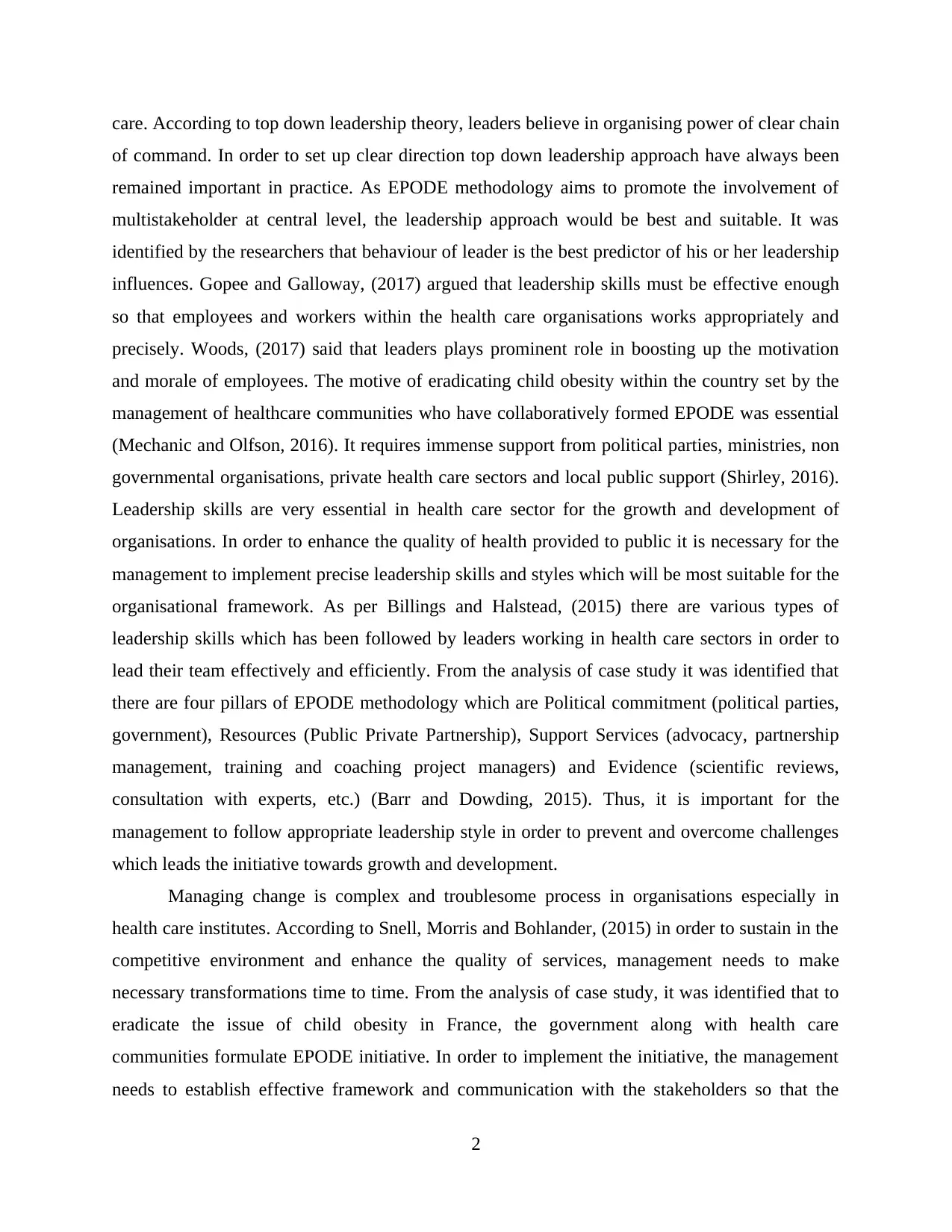
care. According to top down leadership theory, leaders believe in organising power of clear chain
of command. In order to set up clear direction top down leadership approach have always been
remained important in practice. As EPODE methodology aims to promote the involvement of
multistakeholder at central level, the leadership approach would be best and suitable. It was
identified by the researchers that behaviour of leader is the best predictor of his or her leadership
influences. Gopee and Galloway, (2017) argued that leadership skills must be effective enough
so that employees and workers within the health care organisations works appropriately and
precisely. Woods, (2017) said that leaders plays prominent role in boosting up the motivation
and morale of employees. The motive of eradicating child obesity within the country set by the
management of healthcare communities who have collaboratively formed EPODE was essential
(Mechanic and Olfson, 2016). It requires immense support from political parties, ministries, non
governmental organisations, private health care sectors and local public support (Shirley, 2016).
Leadership skills are very essential in health care sector for the growth and development of
organisations. In order to enhance the quality of health provided to public it is necessary for the
management to implement precise leadership skills and styles which will be most suitable for the
organisational framework. As per Billings and Halstead, (2015) there are various types of
leadership skills which has been followed by leaders working in health care sectors in order to
lead their team effectively and efficiently. From the analysis of case study it was identified that
there are four pillars of EPODE methodology which are Political commitment (political parties,
government), Resources (Public Private Partnership), Support Services (advocacy, partnership
management, training and coaching project managers) and Evidence (scientific reviews,
consultation with experts, etc.) (Barr and Dowding, 2015). Thus, it is important for the
management to follow appropriate leadership style in order to prevent and overcome challenges
which leads the initiative towards growth and development.
Managing change is complex and troublesome process in organisations especially in
health care institutes. According to Snell, Morris and Bohlander, (2015) in order to sustain in the
competitive environment and enhance the quality of services, management needs to make
necessary transformations time to time. From the analysis of case study, it was identified that to
eradicate the issue of child obesity in France, the government along with health care
communities formulate EPODE initiative. In order to implement the initiative, the management
needs to establish effective framework and communication with the stakeholders so that the
2
of command. In order to set up clear direction top down leadership approach have always been
remained important in practice. As EPODE methodology aims to promote the involvement of
multistakeholder at central level, the leadership approach would be best and suitable. It was
identified by the researchers that behaviour of leader is the best predictor of his or her leadership
influences. Gopee and Galloway, (2017) argued that leadership skills must be effective enough
so that employees and workers within the health care organisations works appropriately and
precisely. Woods, (2017) said that leaders plays prominent role in boosting up the motivation
and morale of employees. The motive of eradicating child obesity within the country set by the
management of healthcare communities who have collaboratively formed EPODE was essential
(Mechanic and Olfson, 2016). It requires immense support from political parties, ministries, non
governmental organisations, private health care sectors and local public support (Shirley, 2016).
Leadership skills are very essential in health care sector for the growth and development of
organisations. In order to enhance the quality of health provided to public it is necessary for the
management to implement precise leadership skills and styles which will be most suitable for the
organisational framework. As per Billings and Halstead, (2015) there are various types of
leadership skills which has been followed by leaders working in health care sectors in order to
lead their team effectively and efficiently. From the analysis of case study it was identified that
there are four pillars of EPODE methodology which are Political commitment (political parties,
government), Resources (Public Private Partnership), Support Services (advocacy, partnership
management, training and coaching project managers) and Evidence (scientific reviews,
consultation with experts, etc.) (Barr and Dowding, 2015). Thus, it is important for the
management to follow appropriate leadership style in order to prevent and overcome challenges
which leads the initiative towards growth and development.
Managing change is complex and troublesome process in organisations especially in
health care institutes. According to Snell, Morris and Bohlander, (2015) in order to sustain in the
competitive environment and enhance the quality of services, management needs to make
necessary transformations time to time. From the analysis of case study, it was identified that to
eradicate the issue of child obesity in France, the government along with health care
communities formulate EPODE initiative. In order to implement the initiative, the management
needs to establish effective framework and communication with the stakeholders so that the
2
Secure Best Marks with AI Grader
Need help grading? Try our AI Grader for instant feedback on your assignments.
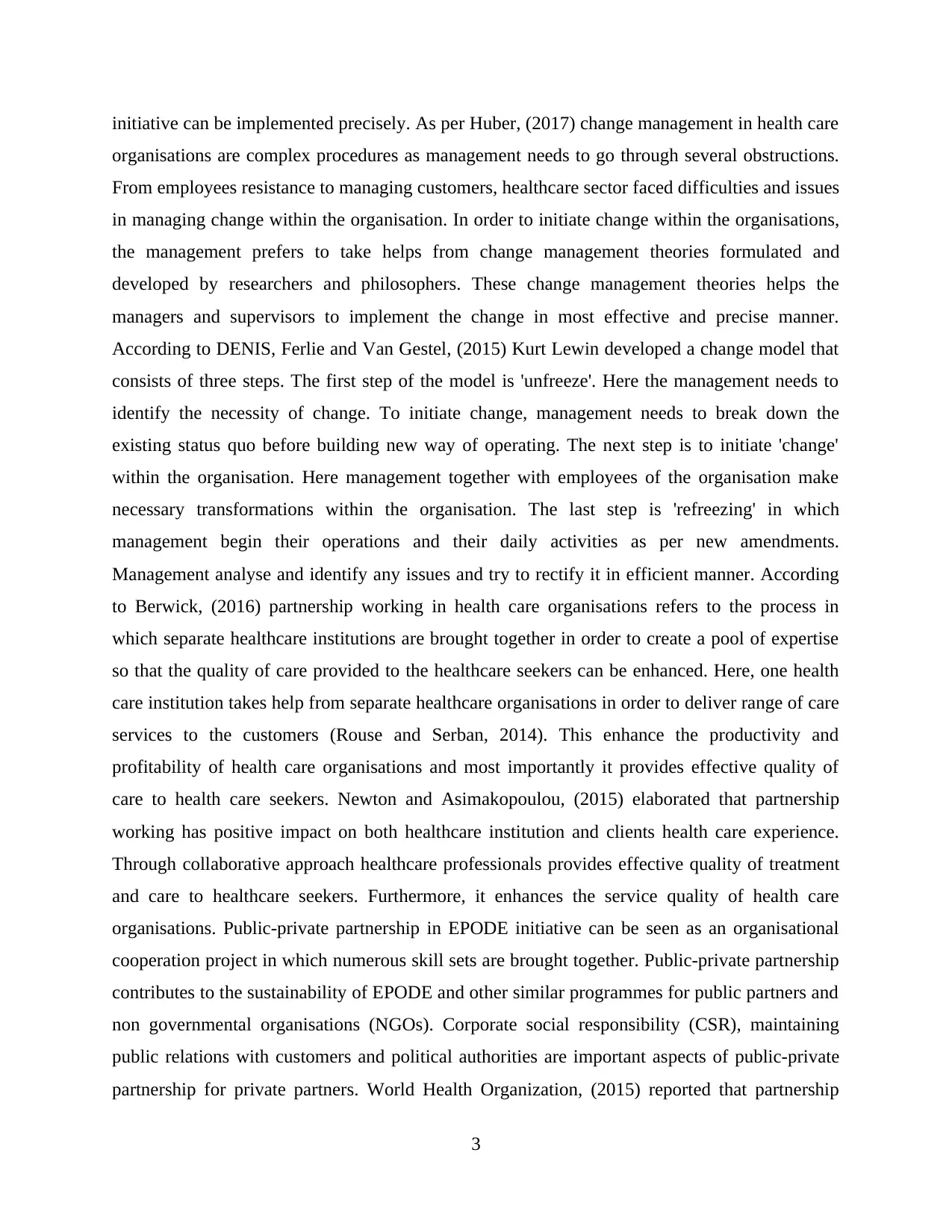
initiative can be implemented precisely. As per Huber, (2017) change management in health care
organisations are complex procedures as management needs to go through several obstructions.
From employees resistance to managing customers, healthcare sector faced difficulties and issues
in managing change within the organisation. In order to initiate change within the organisations,
the management prefers to take helps from change management theories formulated and
developed by researchers and philosophers. These change management theories helps the
managers and supervisors to implement the change in most effective and precise manner.
According to DENIS, Ferlie and Van Gestel, (2015) Kurt Lewin developed a change model that
consists of three steps. The first step of the model is 'unfreeze'. Here the management needs to
identify the necessity of change. To initiate change, management needs to break down the
existing status quo before building new way of operating. The next step is to initiate 'change'
within the organisation. Here management together with employees of the organisation make
necessary transformations within the organisation. The last step is 'refreezing' in which
management begin their operations and their daily activities as per new amendments.
Management analyse and identify any issues and try to rectify it in efficient manner. According
to Berwick, (2016) partnership working in health care organisations refers to the process in
which separate healthcare institutions are brought together in order to create a pool of expertise
so that the quality of care provided to the healthcare seekers can be enhanced. Here, one health
care institution takes help from separate healthcare organisations in order to deliver range of care
services to the customers (Rouse and Serban, 2014). This enhance the productivity and
profitability of health care organisations and most importantly it provides effective quality of
care to health care seekers. Newton and Asimakopoulou, (2015) elaborated that partnership
working has positive impact on both healthcare institution and clients health care experience.
Through collaborative approach healthcare professionals provides effective quality of treatment
and care to healthcare seekers. Furthermore, it enhances the service quality of health care
organisations. Public-private partnership in EPODE initiative can be seen as an organisational
cooperation project in which numerous skill sets are brought together. Public-private partnership
contributes to the sustainability of EPODE and other similar programmes for public partners and
non governmental organisations (NGOs). Corporate social responsibility (CSR), maintaining
public relations with customers and political authorities are important aspects of public-private
partnership for private partners. World Health Organization, (2015) reported that partnership
3
organisations are complex procedures as management needs to go through several obstructions.
From employees resistance to managing customers, healthcare sector faced difficulties and issues
in managing change within the organisation. In order to initiate change within the organisations,
the management prefers to take helps from change management theories formulated and
developed by researchers and philosophers. These change management theories helps the
managers and supervisors to implement the change in most effective and precise manner.
According to DENIS, Ferlie and Van Gestel, (2015) Kurt Lewin developed a change model that
consists of three steps. The first step of the model is 'unfreeze'. Here the management needs to
identify the necessity of change. To initiate change, management needs to break down the
existing status quo before building new way of operating. The next step is to initiate 'change'
within the organisation. Here management together with employees of the organisation make
necessary transformations within the organisation. The last step is 'refreezing' in which
management begin their operations and their daily activities as per new amendments.
Management analyse and identify any issues and try to rectify it in efficient manner. According
to Berwick, (2016) partnership working in health care organisations refers to the process in
which separate healthcare institutions are brought together in order to create a pool of expertise
so that the quality of care provided to the healthcare seekers can be enhanced. Here, one health
care institution takes help from separate healthcare organisations in order to deliver range of care
services to the customers (Rouse and Serban, 2014). This enhance the productivity and
profitability of health care organisations and most importantly it provides effective quality of
care to health care seekers. Newton and Asimakopoulou, (2015) elaborated that partnership
working has positive impact on both healthcare institution and clients health care experience.
Through collaborative approach healthcare professionals provides effective quality of treatment
and care to healthcare seekers. Furthermore, it enhances the service quality of health care
organisations. Public-private partnership in EPODE initiative can be seen as an organisational
cooperation project in which numerous skill sets are brought together. Public-private partnership
contributes to the sustainability of EPODE and other similar programmes for public partners and
non governmental organisations (NGOs). Corporate social responsibility (CSR), maintaining
public relations with customers and political authorities are important aspects of public-private
partnership for private partners. World Health Organization, (2015) reported that partnership
3
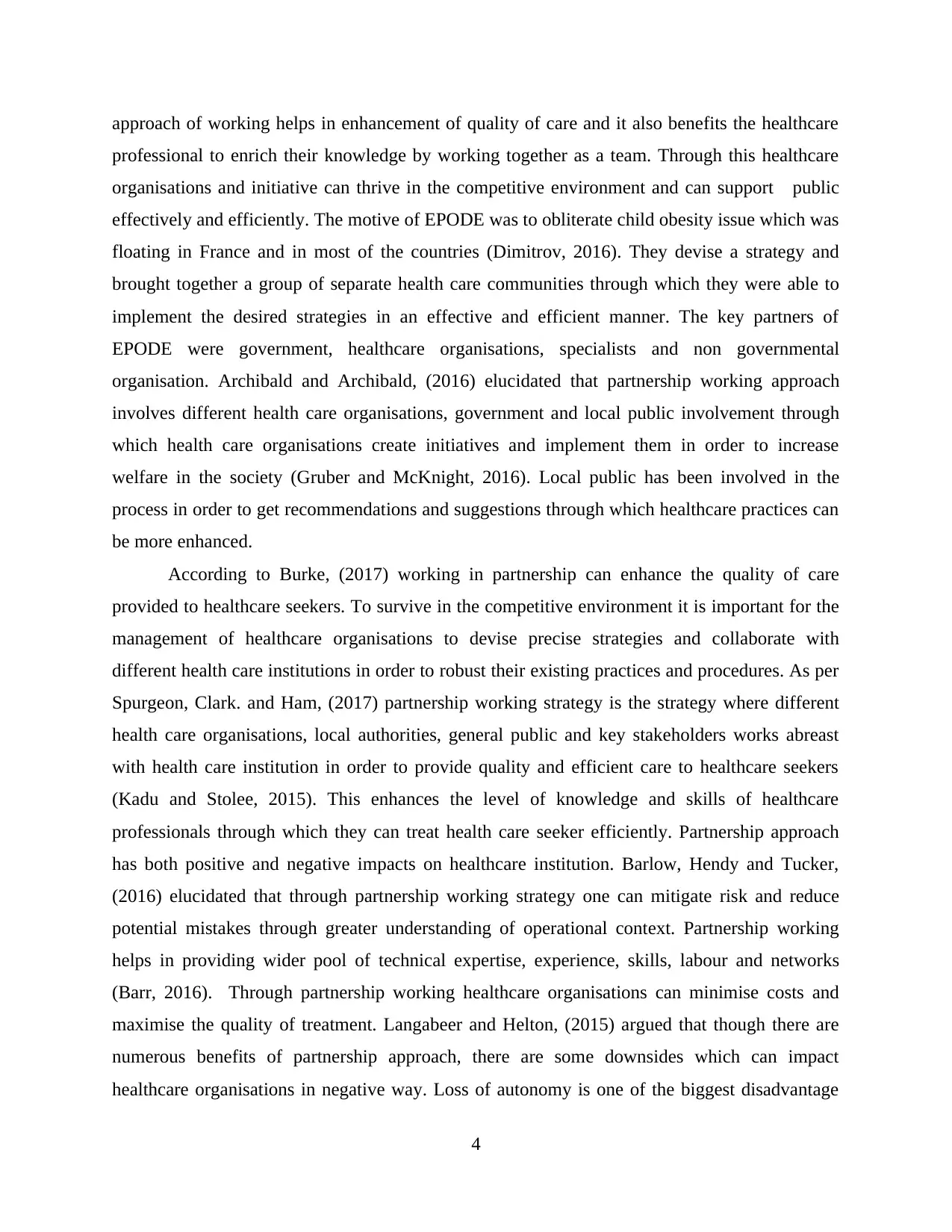
approach of working helps in enhancement of quality of care and it also benefits the healthcare
professional to enrich their knowledge by working together as a team. Through this healthcare
organisations and initiative can thrive in the competitive environment and can support public
effectively and efficiently. The motive of EPODE was to obliterate child obesity issue which was
floating in France and in most of the countries (Dimitrov, 2016). They devise a strategy and
brought together a group of separate health care communities through which they were able to
implement the desired strategies in an effective and efficient manner. The key partners of
EPODE were government, healthcare organisations, specialists and non governmental
organisation. Archibald and Archibald, (2016) elucidated that partnership working approach
involves different health care organisations, government and local public involvement through
which health care organisations create initiatives and implement them in order to increase
welfare in the society (Gruber and McKnight, 2016). Local public has been involved in the
process in order to get recommendations and suggestions through which healthcare practices can
be more enhanced.
According to Burke, (2017) working in partnership can enhance the quality of care
provided to healthcare seekers. To survive in the competitive environment it is important for the
management of healthcare organisations to devise precise strategies and collaborate with
different health care institutions in order to robust their existing practices and procedures. As per
Spurgeon, Clark. and Ham, (2017) partnership working strategy is the strategy where different
health care organisations, local authorities, general public and key stakeholders works abreast
with health care institution in order to provide quality and efficient care to healthcare seekers
(Kadu and Stolee, 2015). This enhances the level of knowledge and skills of healthcare
professionals through which they can treat health care seeker efficiently. Partnership approach
has both positive and negative impacts on healthcare institution. Barlow, Hendy and Tucker,
(2016) elucidated that through partnership working strategy one can mitigate risk and reduce
potential mistakes through greater understanding of operational context. Partnership working
helps in providing wider pool of technical expertise, experience, skills, labour and networks
(Barr, 2016). Through partnership working healthcare organisations can minimise costs and
maximise the quality of treatment. Langabeer and Helton, (2015) argued that though there are
numerous benefits of partnership approach, there are some downsides which can impact
healthcare organisations in negative way. Loss of autonomy is one of the biggest disadvantage
4
professional to enrich their knowledge by working together as a team. Through this healthcare
organisations and initiative can thrive in the competitive environment and can support public
effectively and efficiently. The motive of EPODE was to obliterate child obesity issue which was
floating in France and in most of the countries (Dimitrov, 2016). They devise a strategy and
brought together a group of separate health care communities through which they were able to
implement the desired strategies in an effective and efficient manner. The key partners of
EPODE were government, healthcare organisations, specialists and non governmental
organisation. Archibald and Archibald, (2016) elucidated that partnership working approach
involves different health care organisations, government and local public involvement through
which health care organisations create initiatives and implement them in order to increase
welfare in the society (Gruber and McKnight, 2016). Local public has been involved in the
process in order to get recommendations and suggestions through which healthcare practices can
be more enhanced.
According to Burke, (2017) working in partnership can enhance the quality of care
provided to healthcare seekers. To survive in the competitive environment it is important for the
management of healthcare organisations to devise precise strategies and collaborate with
different health care institutions in order to robust their existing practices and procedures. As per
Spurgeon, Clark. and Ham, (2017) partnership working strategy is the strategy where different
health care organisations, local authorities, general public and key stakeholders works abreast
with health care institution in order to provide quality and efficient care to healthcare seekers
(Kadu and Stolee, 2015). This enhances the level of knowledge and skills of healthcare
professionals through which they can treat health care seeker efficiently. Partnership approach
has both positive and negative impacts on healthcare institution. Barlow, Hendy and Tucker,
(2016) elucidated that through partnership working strategy one can mitigate risk and reduce
potential mistakes through greater understanding of operational context. Partnership working
helps in providing wider pool of technical expertise, experience, skills, labour and networks
(Barr, 2016). Through partnership working healthcare organisations can minimise costs and
maximise the quality of treatment. Langabeer and Helton, (2015) argued that though there are
numerous benefits of partnership approach, there are some downsides which can impact
healthcare organisations in negative way. Loss of autonomy is one of the biggest disadvantage
4
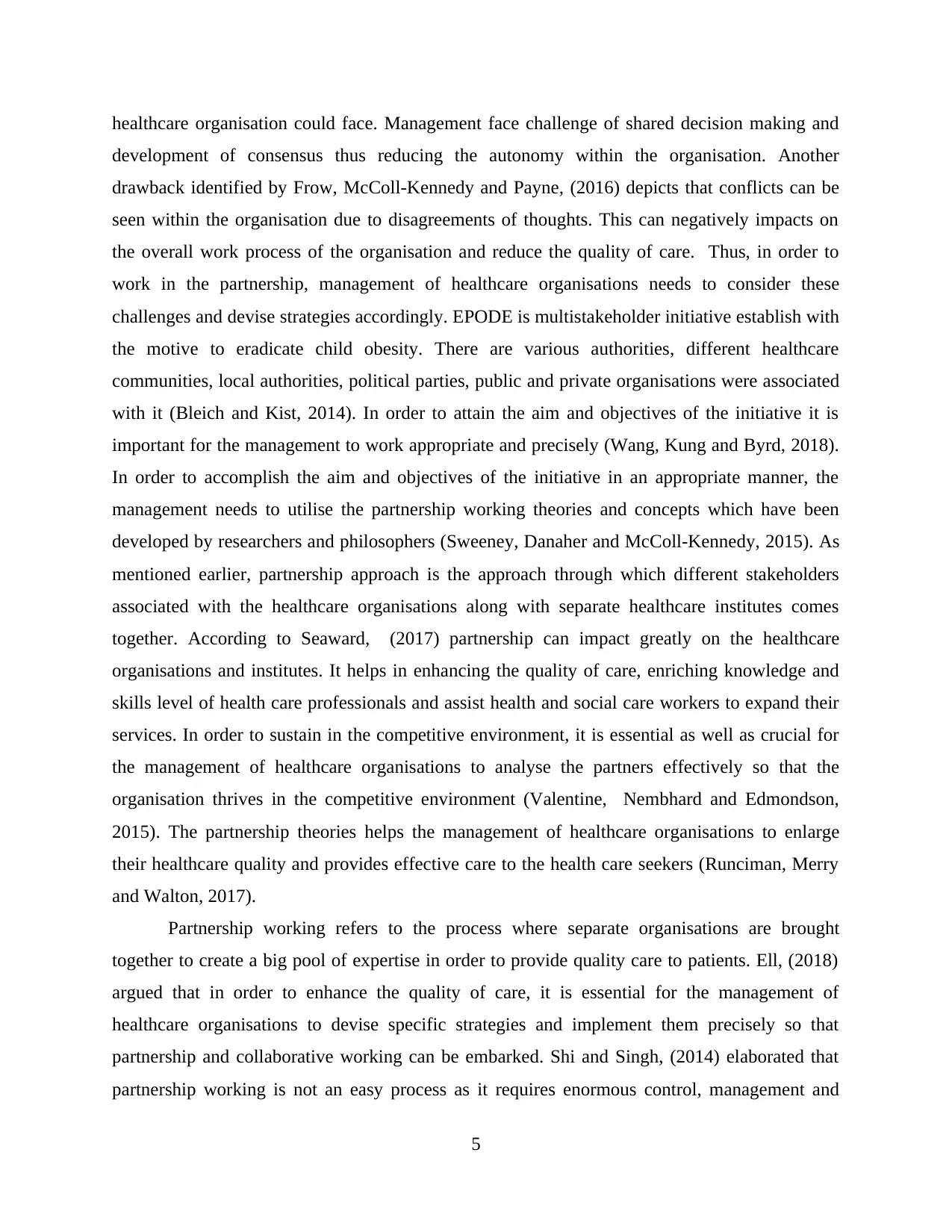
healthcare organisation could face. Management face challenge of shared decision making and
development of consensus thus reducing the autonomy within the organisation. Another
drawback identified by Frow, McColl-Kennedy and Payne, (2016) depicts that conflicts can be
seen within the organisation due to disagreements of thoughts. This can negatively impacts on
the overall work process of the organisation and reduce the quality of care. Thus, in order to
work in the partnership, management of healthcare organisations needs to consider these
challenges and devise strategies accordingly. EPODE is multistakeholder initiative establish with
the motive to eradicate child obesity. There are various authorities, different healthcare
communities, local authorities, political parties, public and private organisations were associated
with it (Bleich and Kist, 2014). In order to attain the aim and objectives of the initiative it is
important for the management to work appropriate and precisely (Wang, Kung and Byrd, 2018).
In order to accomplish the aim and objectives of the initiative in an appropriate manner, the
management needs to utilise the partnership working theories and concepts which have been
developed by researchers and philosophers (Sweeney, Danaher and McColl-Kennedy, 2015). As
mentioned earlier, partnership approach is the approach through which different stakeholders
associated with the healthcare organisations along with separate healthcare institutes comes
together. According to Seaward, (2017) partnership can impact greatly on the healthcare
organisations and institutes. It helps in enhancing the quality of care, enriching knowledge and
skills level of health care professionals and assist health and social care workers to expand their
services. In order to sustain in the competitive environment, it is essential as well as crucial for
the management of healthcare organisations to analyse the partners effectively so that the
organisation thrives in the competitive environment (Valentine, Nembhard and Edmondson,
2015). The partnership theories helps the management of healthcare organisations to enlarge
their healthcare quality and provides effective care to the health care seekers (Runciman, Merry
and Walton, 2017).
Partnership working refers to the process where separate organisations are brought
together to create a big pool of expertise in order to provide quality care to patients. Ell, (2018)
argued that in order to enhance the quality of care, it is essential for the management of
healthcare organisations to devise specific strategies and implement them precisely so that
partnership and collaborative working can be embarked. Shi and Singh, (2014) elaborated that
partnership working is not an easy process as it requires enormous control, management and
5
development of consensus thus reducing the autonomy within the organisation. Another
drawback identified by Frow, McColl-Kennedy and Payne, (2016) depicts that conflicts can be
seen within the organisation due to disagreements of thoughts. This can negatively impacts on
the overall work process of the organisation and reduce the quality of care. Thus, in order to
work in the partnership, management of healthcare organisations needs to consider these
challenges and devise strategies accordingly. EPODE is multistakeholder initiative establish with
the motive to eradicate child obesity. There are various authorities, different healthcare
communities, local authorities, political parties, public and private organisations were associated
with it (Bleich and Kist, 2014). In order to attain the aim and objectives of the initiative it is
important for the management to work appropriate and precisely (Wang, Kung and Byrd, 2018).
In order to accomplish the aim and objectives of the initiative in an appropriate manner, the
management needs to utilise the partnership working theories and concepts which have been
developed by researchers and philosophers (Sweeney, Danaher and McColl-Kennedy, 2015). As
mentioned earlier, partnership approach is the approach through which different stakeholders
associated with the healthcare organisations along with separate healthcare institutes comes
together. According to Seaward, (2017) partnership can impact greatly on the healthcare
organisations and institutes. It helps in enhancing the quality of care, enriching knowledge and
skills level of health care professionals and assist health and social care workers to expand their
services. In order to sustain in the competitive environment, it is essential as well as crucial for
the management of healthcare organisations to analyse the partners effectively so that the
organisation thrives in the competitive environment (Valentine, Nembhard and Edmondson,
2015). The partnership theories helps the management of healthcare organisations to enlarge
their healthcare quality and provides effective care to the health care seekers (Runciman, Merry
and Walton, 2017).
Partnership working refers to the process where separate organisations are brought
together to create a big pool of expertise in order to provide quality care to patients. Ell, (2018)
argued that in order to enhance the quality of care, it is essential for the management of
healthcare organisations to devise specific strategies and implement them precisely so that
partnership and collaborative working can be embarked. Shi and Singh, (2014) elaborated that
partnership working is not an easy process as it requires enormous control, management and
5
Paraphrase This Document
Need a fresh take? Get an instant paraphrase of this document with our AI Paraphraser

direction. The management needs to monitor the activities of partners so that autonomy can be
maintained in the healthcare organisation. EPODE evaluation and monitoring is implemented at
various levels through the collection of information on process indicators (e.g. central
partnerships, local steering committee meetings), output indicators (e.g. the number of local
actions, participation of families and children) and outcome indicators (e.g. changes in dietary
habits, childhood obesity prevalence) (Kwamie, van Dijk and Agyepong, 2014). According to
Dunning, Sinclair and Colagiuri, (2014) in order to meet the needs of healthcare patients and
seekers it is important for the management to work collaboratively with other healthcare
organisation. Public involvement in the healthcare is done by many healthcare organisations in
UK including NHS. It was assumed by researchers that greater public involvement will lead to
more democratic decision making and better accountability (Barrett, Charles and Temte, 2015).
Thus, through involvement of public in healthcare process, the service will become more
responsive to individuals and communities who seeks for the healthcare services.
CONCLUSION
From the above study it can be understood that managing change in the healthcare
organisations are complex and stressful process. In this context, by analysing the case study of
EPODE, the leadership theories and skills were identified. In order to overcome one of the most
complex and critical issue i.e. child obesity, helathcare communities operating in France together
devise a programmed named Ensemble Prévenons l'ObésitéDes Enfants’ (EPODE, Together
Let's Prevent Childhood Obesity). This initiative, which originated in France and is now being
replicated around the world, is working to mitigate or reverse obesity prevalence rates. The
issues relating with leading and managing change has been identified in relation with case study.
to eradicate the issue of child obesity in France, the government along with health care
communities formulate EPODE initiative. The critical analysis of processes and potential impact
of partnership working has been assessed in the report and Kurt Lewin change management
theory has been described. The role of partnership working in public health and strategies
for partnership and public involvement has bee described in the study.
6
maintained in the healthcare organisation. EPODE evaluation and monitoring is implemented at
various levels through the collection of information on process indicators (e.g. central
partnerships, local steering committee meetings), output indicators (e.g. the number of local
actions, participation of families and children) and outcome indicators (e.g. changes in dietary
habits, childhood obesity prevalence) (Kwamie, van Dijk and Agyepong, 2014). According to
Dunning, Sinclair and Colagiuri, (2014) in order to meet the needs of healthcare patients and
seekers it is important for the management to work collaboratively with other healthcare
organisation. Public involvement in the healthcare is done by many healthcare organisations in
UK including NHS. It was assumed by researchers that greater public involvement will lead to
more democratic decision making and better accountability (Barrett, Charles and Temte, 2015).
Thus, through involvement of public in healthcare process, the service will become more
responsive to individuals and communities who seeks for the healthcare services.
CONCLUSION
From the above study it can be understood that managing change in the healthcare
organisations are complex and stressful process. In this context, by analysing the case study of
EPODE, the leadership theories and skills were identified. In order to overcome one of the most
complex and critical issue i.e. child obesity, helathcare communities operating in France together
devise a programmed named Ensemble Prévenons l'ObésitéDes Enfants’ (EPODE, Together
Let's Prevent Childhood Obesity). This initiative, which originated in France and is now being
replicated around the world, is working to mitigate or reverse obesity prevalence rates. The
issues relating with leading and managing change has been identified in relation with case study.
to eradicate the issue of child obesity in France, the government along with health care
communities formulate EPODE initiative. The critical analysis of processes and potential impact
of partnership working has been assessed in the report and Kurt Lewin change management
theory has been described. The role of partnership working in public health and strategies
for partnership and public involvement has bee described in the study.
6
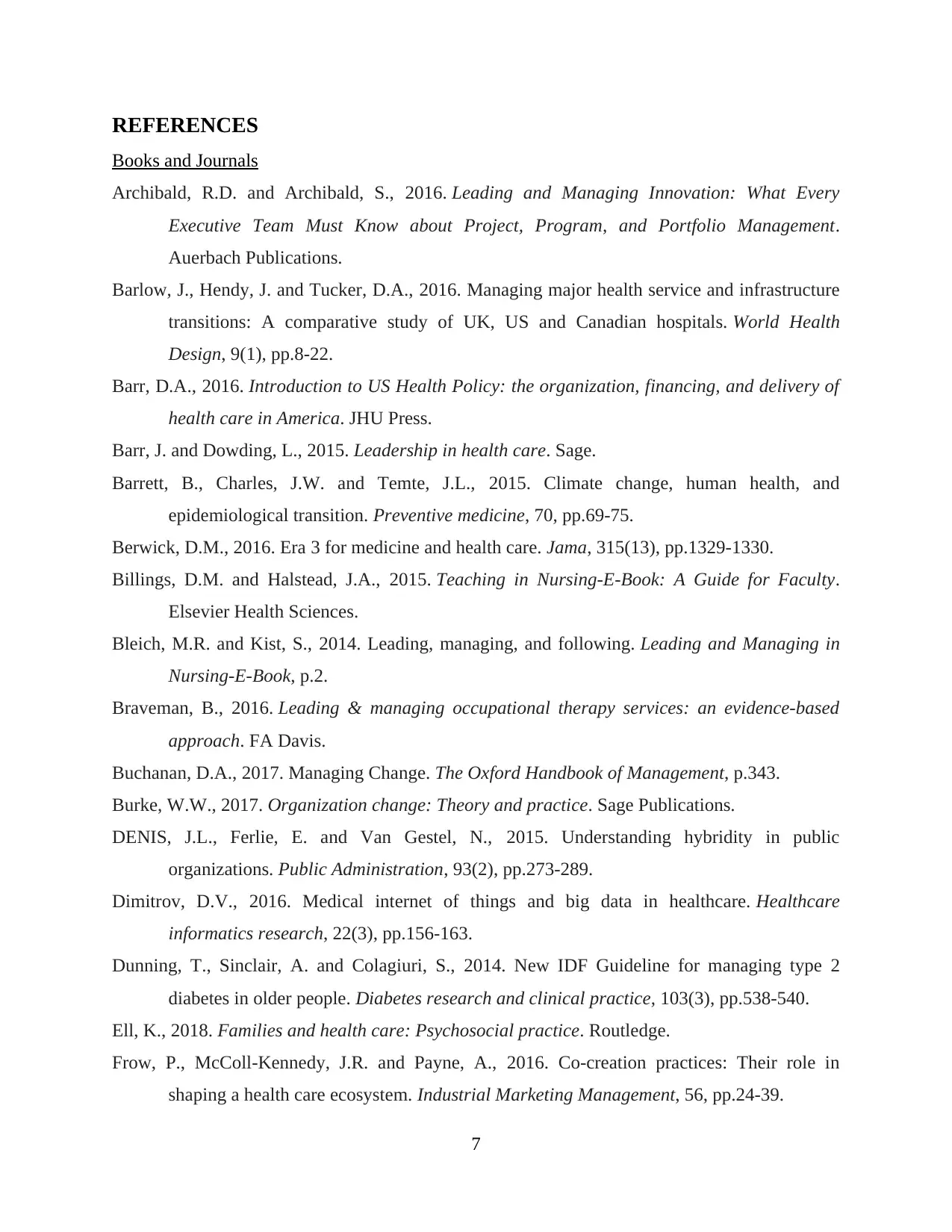
REFERENCES
Books and Journals
Archibald, R.D. and Archibald, S., 2016. Leading and Managing Innovation: What Every
Executive Team Must Know about Project, Program, and Portfolio Management.
Auerbach Publications.
Barlow, J., Hendy, J. and Tucker, D.A., 2016. Managing major health service and infrastructure
transitions: A comparative study of UK, US and Canadian hospitals. World Health
Design, 9(1), pp.8-22.
Barr, D.A., 2016. Introduction to US Health Policy: the organization, financing, and delivery of
health care in America. JHU Press.
Barr, J. and Dowding, L., 2015. Leadership in health care. Sage.
Barrett, B., Charles, J.W. and Temte, J.L., 2015. Climate change, human health, and
epidemiological transition. Preventive medicine, 70, pp.69-75.
Berwick, D.M., 2016. Era 3 for medicine and health care. Jama, 315(13), pp.1329-1330.
Billings, D.M. and Halstead, J.A., 2015. Teaching in Nursing-E-Book: A Guide for Faculty.
Elsevier Health Sciences.
Bleich, M.R. and Kist, S., 2014. Leading, managing, and following. Leading and Managing in
Nursing-E-Book, p.2.
Braveman, B., 2016. Leading & managing occupational therapy services: an evidence-based
approach. FA Davis.
Buchanan, D.A., 2017. Managing Change. The Oxford Handbook of Management, p.343.
Burke, W.W., 2017. Organization change: Theory and practice. Sage Publications.
DENIS, J.L., Ferlie, E. and Van Gestel, N., 2015. Understanding hybridity in public
organizations. Public Administration, 93(2), pp.273-289.
Dimitrov, D.V., 2016. Medical internet of things and big data in healthcare. Healthcare
informatics research, 22(3), pp.156-163.
Dunning, T., Sinclair, A. and Colagiuri, S., 2014. New IDF Guideline for managing type 2
diabetes in older people. Diabetes research and clinical practice, 103(3), pp.538-540.
Ell, K., 2018. Families and health care: Psychosocial practice. Routledge.
Frow, P., McColl-Kennedy, J.R. and Payne, A., 2016. Co-creation practices: Their role in
shaping a health care ecosystem. Industrial Marketing Management, 56, pp.24-39.
7
Books and Journals
Archibald, R.D. and Archibald, S., 2016. Leading and Managing Innovation: What Every
Executive Team Must Know about Project, Program, and Portfolio Management.
Auerbach Publications.
Barlow, J., Hendy, J. and Tucker, D.A., 2016. Managing major health service and infrastructure
transitions: A comparative study of UK, US and Canadian hospitals. World Health
Design, 9(1), pp.8-22.
Barr, D.A., 2016. Introduction to US Health Policy: the organization, financing, and delivery of
health care in America. JHU Press.
Barr, J. and Dowding, L., 2015. Leadership in health care. Sage.
Barrett, B., Charles, J.W. and Temte, J.L., 2015. Climate change, human health, and
epidemiological transition. Preventive medicine, 70, pp.69-75.
Berwick, D.M., 2016. Era 3 for medicine and health care. Jama, 315(13), pp.1329-1330.
Billings, D.M. and Halstead, J.A., 2015. Teaching in Nursing-E-Book: A Guide for Faculty.
Elsevier Health Sciences.
Bleich, M.R. and Kist, S., 2014. Leading, managing, and following. Leading and Managing in
Nursing-E-Book, p.2.
Braveman, B., 2016. Leading & managing occupational therapy services: an evidence-based
approach. FA Davis.
Buchanan, D.A., 2017. Managing Change. The Oxford Handbook of Management, p.343.
Burke, W.W., 2017. Organization change: Theory and practice. Sage Publications.
DENIS, J.L., Ferlie, E. and Van Gestel, N., 2015. Understanding hybridity in public
organizations. Public Administration, 93(2), pp.273-289.
Dimitrov, D.V., 2016. Medical internet of things and big data in healthcare. Healthcare
informatics research, 22(3), pp.156-163.
Dunning, T., Sinclair, A. and Colagiuri, S., 2014. New IDF Guideline for managing type 2
diabetes in older people. Diabetes research and clinical practice, 103(3), pp.538-540.
Ell, K., 2018. Families and health care: Psychosocial practice. Routledge.
Frow, P., McColl-Kennedy, J.R. and Payne, A., 2016. Co-creation practices: Their role in
shaping a health care ecosystem. Industrial Marketing Management, 56, pp.24-39.
7
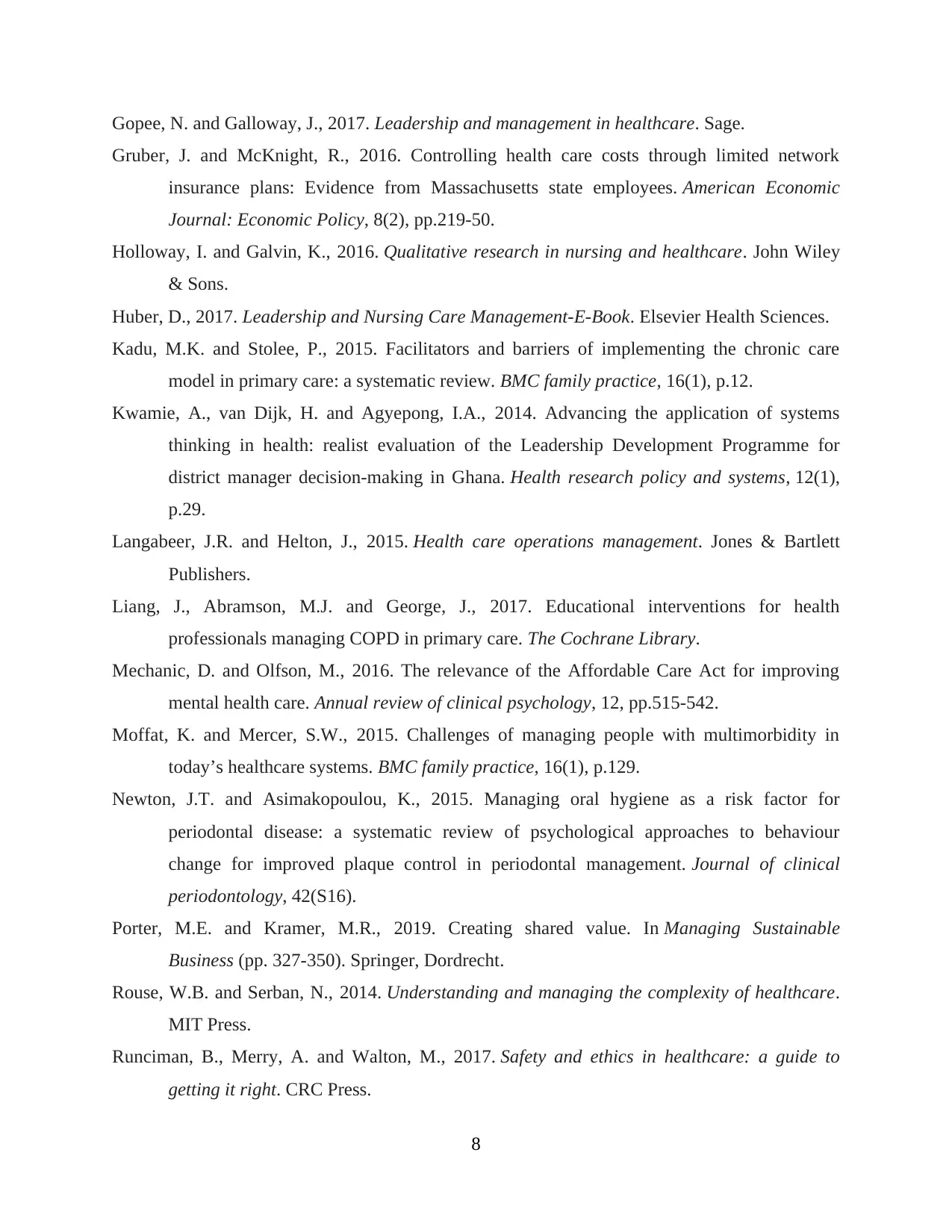
Gopee, N. and Galloway, J., 2017. Leadership and management in healthcare. Sage.
Gruber, J. and McKnight, R., 2016. Controlling health care costs through limited network
insurance plans: Evidence from Massachusetts state employees. American Economic
Journal: Economic Policy, 8(2), pp.219-50.
Holloway, I. and Galvin, K., 2016. Qualitative research in nursing and healthcare. John Wiley
& Sons.
Huber, D., 2017. Leadership and Nursing Care Management-E-Book. Elsevier Health Sciences.
Kadu, M.K. and Stolee, P., 2015. Facilitators and barriers of implementing the chronic care
model in primary care: a systematic review. BMC family practice, 16(1), p.12.
Kwamie, A., van Dijk, H. and Agyepong, I.A., 2014. Advancing the application of systems
thinking in health: realist evaluation of the Leadership Development Programme for
district manager decision-making in Ghana. Health research policy and systems, 12(1),
p.29.
Langabeer, J.R. and Helton, J., 2015. Health care operations management. Jones & Bartlett
Publishers.
Liang, J., Abramson, M.J. and George, J., 2017. Educational interventions for health
professionals managing COPD in primary care. The Cochrane Library.
Mechanic, D. and Olfson, M., 2016. The relevance of the Affordable Care Act for improving
mental health care. Annual review of clinical psychology, 12, pp.515-542.
Moffat, K. and Mercer, S.W., 2015. Challenges of managing people with multimorbidity in
today’s healthcare systems. BMC family practice, 16(1), p.129.
Newton, J.T. and Asimakopoulou, K., 2015. Managing oral hygiene as a risk factor for
periodontal disease: a systematic review of psychological approaches to behaviour
change for improved plaque control in periodontal management. Journal of clinical
periodontology, 42(S16).
Porter, M.E. and Kramer, M.R., 2019. Creating shared value. In Managing Sustainable
Business (pp. 327-350). Springer, Dordrecht.
Rouse, W.B. and Serban, N., 2014. Understanding and managing the complexity of healthcare.
MIT Press.
Runciman, B., Merry, A. and Walton, M., 2017. Safety and ethics in healthcare: a guide to
getting it right. CRC Press.
8
Gruber, J. and McKnight, R., 2016. Controlling health care costs through limited network
insurance plans: Evidence from Massachusetts state employees. American Economic
Journal: Economic Policy, 8(2), pp.219-50.
Holloway, I. and Galvin, K., 2016. Qualitative research in nursing and healthcare. John Wiley
& Sons.
Huber, D., 2017. Leadership and Nursing Care Management-E-Book. Elsevier Health Sciences.
Kadu, M.K. and Stolee, P., 2015. Facilitators and barriers of implementing the chronic care
model in primary care: a systematic review. BMC family practice, 16(1), p.12.
Kwamie, A., van Dijk, H. and Agyepong, I.A., 2014. Advancing the application of systems
thinking in health: realist evaluation of the Leadership Development Programme for
district manager decision-making in Ghana. Health research policy and systems, 12(1),
p.29.
Langabeer, J.R. and Helton, J., 2015. Health care operations management. Jones & Bartlett
Publishers.
Liang, J., Abramson, M.J. and George, J., 2017. Educational interventions for health
professionals managing COPD in primary care. The Cochrane Library.
Mechanic, D. and Olfson, M., 2016. The relevance of the Affordable Care Act for improving
mental health care. Annual review of clinical psychology, 12, pp.515-542.
Moffat, K. and Mercer, S.W., 2015. Challenges of managing people with multimorbidity in
today’s healthcare systems. BMC family practice, 16(1), p.129.
Newton, J.T. and Asimakopoulou, K., 2015. Managing oral hygiene as a risk factor for
periodontal disease: a systematic review of psychological approaches to behaviour
change for improved plaque control in periodontal management. Journal of clinical
periodontology, 42(S16).
Porter, M.E. and Kramer, M.R., 2019. Creating shared value. In Managing Sustainable
Business (pp. 327-350). Springer, Dordrecht.
Rouse, W.B. and Serban, N., 2014. Understanding and managing the complexity of healthcare.
MIT Press.
Runciman, B., Merry, A. and Walton, M., 2017. Safety and ethics in healthcare: a guide to
getting it right. CRC Press.
8
Secure Best Marks with AI Grader
Need help grading? Try our AI Grader for instant feedback on your assignments.
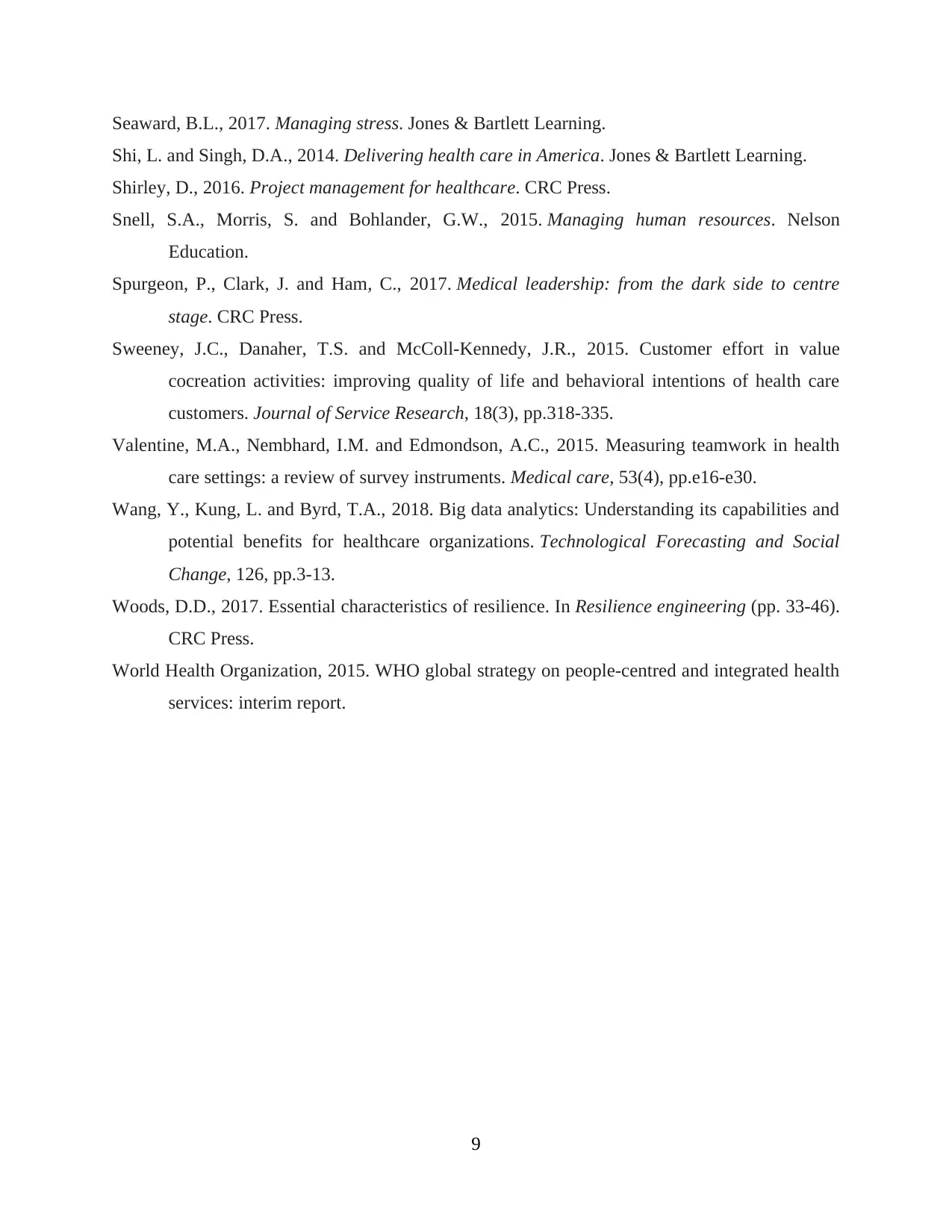
Seaward, B.L., 2017. Managing stress. Jones & Bartlett Learning.
Shi, L. and Singh, D.A., 2014. Delivering health care in America. Jones & Bartlett Learning.
Shirley, D., 2016. Project management for healthcare. CRC Press.
Snell, S.A., Morris, S. and Bohlander, G.W., 2015. Managing human resources. Nelson
Education.
Spurgeon, P., Clark, J. and Ham, C., 2017. Medical leadership: from the dark side to centre
stage. CRC Press.
Sweeney, J.C., Danaher, T.S. and McColl-Kennedy, J.R., 2015. Customer effort in value
cocreation activities: improving quality of life and behavioral intentions of health care
customers. Journal of Service Research, 18(3), pp.318-335.
Valentine, M.A., Nembhard, I.M. and Edmondson, A.C., 2015. Measuring teamwork in health
care settings: a review of survey instruments. Medical care, 53(4), pp.e16-e30.
Wang, Y., Kung, L. and Byrd, T.A., 2018. Big data analytics: Understanding its capabilities and
potential benefits for healthcare organizations. Technological Forecasting and Social
Change, 126, pp.3-13.
Woods, D.D., 2017. Essential characteristics of resilience. In Resilience engineering (pp. 33-46).
CRC Press.
World Health Organization, 2015. WHO global strategy on people-centred and integrated health
services: interim report.
9
Shi, L. and Singh, D.A., 2014. Delivering health care in America. Jones & Bartlett Learning.
Shirley, D., 2016. Project management for healthcare. CRC Press.
Snell, S.A., Morris, S. and Bohlander, G.W., 2015. Managing human resources. Nelson
Education.
Spurgeon, P., Clark, J. and Ham, C., 2017. Medical leadership: from the dark side to centre
stage. CRC Press.
Sweeney, J.C., Danaher, T.S. and McColl-Kennedy, J.R., 2015. Customer effort in value
cocreation activities: improving quality of life and behavioral intentions of health care
customers. Journal of Service Research, 18(3), pp.318-335.
Valentine, M.A., Nembhard, I.M. and Edmondson, A.C., 2015. Measuring teamwork in health
care settings: a review of survey instruments. Medical care, 53(4), pp.e16-e30.
Wang, Y., Kung, L. and Byrd, T.A., 2018. Big data analytics: Understanding its capabilities and
potential benefits for healthcare organizations. Technological Forecasting and Social
Change, 126, pp.3-13.
Woods, D.D., 2017. Essential characteristics of resilience. In Resilience engineering (pp. 33-46).
CRC Press.
World Health Organization, 2015. WHO global strategy on people-centred and integrated health
services: interim report.
9
1 out of 11
Related Documents
Your All-in-One AI-Powered Toolkit for Academic Success.
+13062052269
info@desklib.com
Available 24*7 on WhatsApp / Email
![[object Object]](/_next/static/media/star-bottom.7253800d.svg)
Unlock your academic potential
© 2024 | Zucol Services PVT LTD | All rights reserved.





